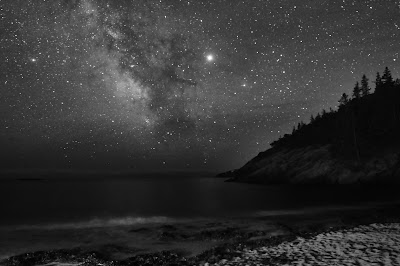We can allow satellites, planets, suns,
universe, nay whole systems of universes,
to be governed by laws, but the smallest insect,
we wish to be created at once by special act.
--Charles Darwin
Panorama of Milky Way - 40 photos (it takes about 1 hour). On this photo you can see Orion, Crux (Southern Cross), Canis Major, Carinae, Centaurus Constellations, and three brightest stars of the Earth sky: Sirius, Canopus and Rigel Kentaurus. The night sky airglow (red and green sheen) is visible on this panorama too.
 |
| Milky Way over Galapagos Astrophotography |
Canon EOS 60Da, EF16-35mm f/2.8L II USM, 16.0 sec; f/2.8; ISO 6400, Puerto Villamil, Isabela Island, Galapagos, Ecuador.
One more photo: "How to Train Your Dragon"
The marine iguana (Amblyrhynchus cristatus), also known as the sea iguana, saltwater iguana, or Galapagos marine iguana, is a species of iguana found only on the Galápagos Islands (Ecuador) that has the ability, unique among modern lizards, to forage in the sea, making it a marine reptile.
 |
| How to Train Your Dragon or Milky Way over Galapagos Astrophotography |
Not so much were changes on Galapagos Islands during last 3 millions years!
The blue-footed booby (Sula nebouxii) is a marine bird. The blue-footed booby is distributed among the continental coasts of the eastern Pacific Ocean from California to the Galapagos Islands down into Peru. The blue color of the blue-footed booby's webbed feet comes from carotenoid pigments obtained from its diet of fresh fish.
 |
| The blue-footed booby and Milky Way Isabela Island Galapagos Ecuador |
Frigatebirds (also listed as "frigate bird", "frigate-bird", "frigate", "frigate-petrel") are a family of seabirds called Fregatidae which are found across all tropical and subtropical oceans. Females have white underbellies and males have a distinctive red gular pouch, which they inflate during the breeding season to attract females.
 |
| Frigate-bird and Milky Way - Galapagos Islands |
Darwin's finches (also known as the Galapagos finches) are a group of about 15 species of passerine birds. During the survey voyage of HMS Beagle, Darwin was unaware of the significance of the birds of the Galapagos. These birds were to play an important part in the inception of Darwin's theory of evolution by natural selection.
 |
| Darwin's Galapagos finch and night cloudy sky Santa Cruz Island |
Most of Galapagos Flamingo plumage is pink, giving rise to its earlier name of Rosy Flamingo and differentiating adults from the much paler European species. Flamingos can only eat with their head upside down. Their beaks have lamellae (thin, flat membranes) which are used to filter the mud.
 |
| Galapagos Flamingo and Milky Way Astrophotography |
The Galapagos tortoise are the largest living species of tortoise. Modern Galapagos tortoises can weigh up to 417 kg (919 lb). Today, giant tortoises exist on only two remote archipelagos: the Galapagos Islands 1000 km due west of mainland Ecuador; and Aldabrachelys gigantea of Aldabra in the Indian Ocean, 700 km east of Tanzania.
 |
| Galapagos giant tortoise and Orion - night sky |
















































